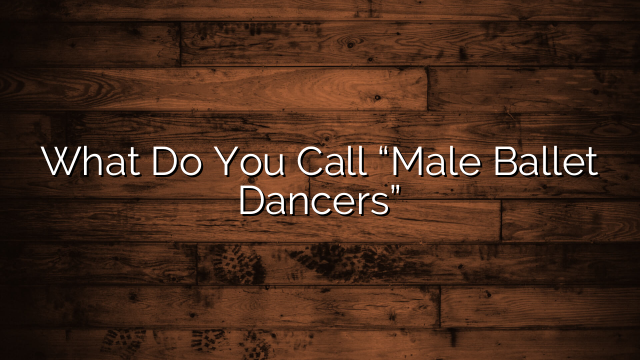In the mesmerizing world of ballet, where grace and precision intertwine, male dancers play an integral role. They possess a unique ability to captivate audiences with their strength, agility, and artistic expressions.
While we are familiar with the term ‘ballet dancer,’ it is essential to delve deeper into the terminology surrounding these talented performers. This article aims to unravel the enigma of what one calls male ballet dancers. With an analytical lens, we will explore the various terms used within the realm of ballet and shed light on their significance.
By understanding these terminologies, we can appreciate the distinct roles that male dancers play in this art form. Through critical analysis and knowledgeable insights, we will navigate through the world of danseurs—the appropriate term for male ballet artists—and unveil other names associated with them.
Join us as we embark on this journey to gain a deeper understanding of how these remarkable individuals contribute to the captivating universe of ballet.
Key Takeaways
- Male ballet dancers bring strength, agility, and artistic expressions to the ballet world.
- They challenge gender stereotypes and promote inclusivity within the industry.
- Terminology used for male ballet dancers is evolving towards more gender-neutral terms.
- Recognizing their contributions creates a more inclusive environment and celebrates their journey.
Ballet Dancers: Understanding the Terminology
Ballet dancers, regardless of gender, are skilled performers who possess an exceptional ability to seamlessly blend graceful movements with technical precision, captivating audiences with their ethereal presence on stage.
The importance of male representation in ballet cannot be understated. Traditionally dominated by female dancers, the inclusion of male dancers not only adds diversity and depth to performances but also challenges existing gender stereotypes within the art form.
Male ballet dancers bring a unique strength and athleticism to their movements, often partnering with female dancers to create breathtaking displays of physicality and grace. By showcasing their talent and defying societal expectations, male ballet dancers play a vital role in breaking down barriers and promoting inclusivity within the world of ballet.
Their contributions highlight the evolving nature of this classical art form and inspire future generations to pursue their passion without limitation.
Danseurs and Their Role in Ballet
In the realm of classical dance, danseurs play an essential role as male performers who gracefully bring to life the choreographic visions of ballet masters.
Throughout history, the evolution of male roles in ballet has been marked by significant changes. Traditionally, male dancers were confined to supporting roles, but today they have gained recognition for their own artistry and technical prowess.
However, this progress has not come without challenges. Male ballet dancers face unique obstacles in the industry, including societal stereotypes that question their masculinity and limited opportunities for advancement compared to their female counterparts. Additionally, they must overcome physical demands such as strength and flexibility requirements that are often associated with female dancers.
Despite these obstacles, talented danseurs continue to defy expectations and prove that male ballet dancers are vital contributors to the world of classical dance.
-
The perseverance displayed by male ballet dancers inspires admiration from audiences.
-
The exploration of gender norms within ballet challenges societal expectations.
-
The achievements of male dancers showcase the diversity and inclusivity of the art form.
Exploring the World of Male Ballet Performers
Male ballet performers are an integral part of the dance world, showcasing their technical skill and artistic expression on stage. However, they face numerous challenges in a traditionally female-dominated industry.
One significant challenge is the societal perception that ballet is primarily for women, leading to limited opportunities and biases against male dancers. Another hurdle is the physical demands placed on male ballet performers, requiring them to possess both strength and flexibility beyond what is typically expected of men in other professions.
Despite these obstacles, the evolution of male ballet roles has started to challenge traditional gender stereotypes in dance. Male dancers are now being given more prominent roles that highlight their athleticism and power, breaking away from the notion that ballet is solely feminine.
This shift not only provides more diverse opportunities for male performers but also promotes inclusivity within the art form as a whole.
The Appropriate Terms for Male Ballet Artists
The terminology used to refer to male ballet artists is a topic of discussion within the dance community. While historically, male ballet dancers were referred to as ‘danseurs’ or ‘danseurs nobles,’ there has been a shift towards using more gender-neutral terms such as ‘male ballet dancers.’ This change reflects the efforts to break gender stereotypes in the performing arts and promote inclusivity.
-
Male ballet dancers: breaking gender stereotypes in the performing arts
-
The challenges and triumphs of being a male ballet dancer in a predominantly female industry
-
The impact of language on perceptions and opportunities for male ballet dancers
Being a male ballet dancer in a predominantly female industry comes with its own set of challenges and triumphs. On one hand, there are limited opportunities and role options available compared to their female counterparts. However, this scarcity can also lead to unique roles that showcase strength and athleticism.
Additionally, society’s perception of masculinity often clashes with traditional notions of ballet as an art form, making it important for male dancers to navigate societal expectations while expressing themselves authentically through their craft.
Overall, the appropriate terminology for male ballet artists continues to evolve alongside changing societal attitudes towards gender roles. By recognizing their contributions and experiences, we can create a more inclusive environment that celebrates the talent and dedication of all dancers regardless of gender.
Unveiling the Names for Male Ballet Dancers
One significant aspect of the ballet community involves the unveiling and recognition of appropriate terms to describe male performers in this art form.
In recent years, there has been a growing emphasis on gender equality in ballet, aiming to break the stereotypes that have long plagued male dancers.
Traditionally, male ballet dancers were often referred to as ‘danseur’ or ‘danseur noble,’ emphasizing their strength and partnering abilities. However, these terms can perpetuate the notion that male dancers are secondary to their female counterparts.
As such, there has been a shift towards using more inclusive terminology, such as ‘male dancer’ or simply ‘dancer.’ This change reflects a broader effort to acknowledge and celebrate the journey of male ballet dancers who face unique challenges but also experience triumphs on their path to success.
By promoting gender equality in language and practice, the ballet community is fostering a more inclusive environment for all performers.
Frequently Asked Questions
How long does it take for a male ballet dancer to reach a professional level?
The training intensity required for male ballet dancers to reach a professional level varies, but typically takes several years of rigorous practice. Career longevity is dependent on factors such as physical fitness and the ability to adapt to changing dance styles.
What are the physical requirements for male ballet dancers?
Male ballet dancers must possess exceptional physical attributes such as strength, flexibility, and agility to meet the physical challenges of their profession. Training techniques focus on developing these qualities through rigorous exercises and specialized conditioning programs.
Are male ballet dancers more prone to injuries compared to female ballet dancers?
Male ballet dancers may face unique challenges in the ballet world, putting them at a higher risk of career-ending injuries compared to their female counterparts. This analysis highlights the need for further research and support for male dancers’ physical health in this demanding profession.
How has the perception of male ballet dancers changed over time?
The perception of male ballet dancers has evolved over time due to changing stereotypes and increased representation in popular culture. This has led to a greater understanding and appreciation for their skill, athleticism, and artistry.
What opportunities are available for male ballet dancers outside of traditional ballet companies?
Opportunities for male ballet dancers outside of traditional ballet companies include joining contemporary dance companies, exploring different dance styles, and challenging gender roles. This allows for greater diversity and representation in the field of dance.
Conclusion
In this academic exploration of ballet terminology, we have delved into the world of male ballet dancers. We have examined their role in the art form and uncovered the appropriate terms to refer to them.
By adopting an analytical and critical approach, we have shed light on the names for these talented individuals. It is fascinating to see how language evolves and adapts to different cultural contexts.
This research has provided valuable insight into the intricate world of ballet terminology, challenging preconceived notions along the way.



